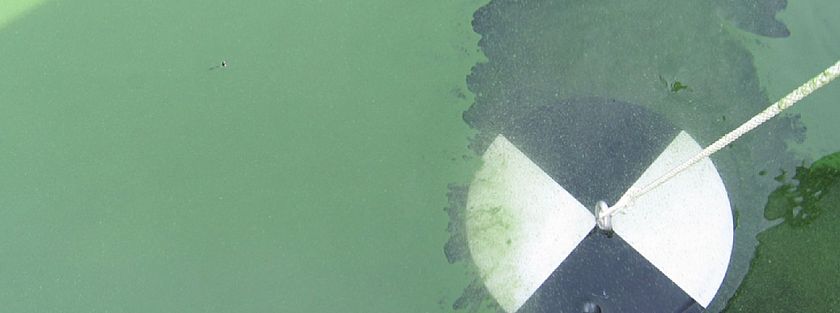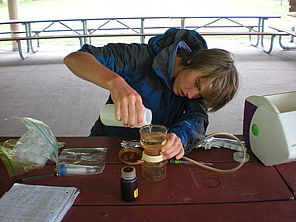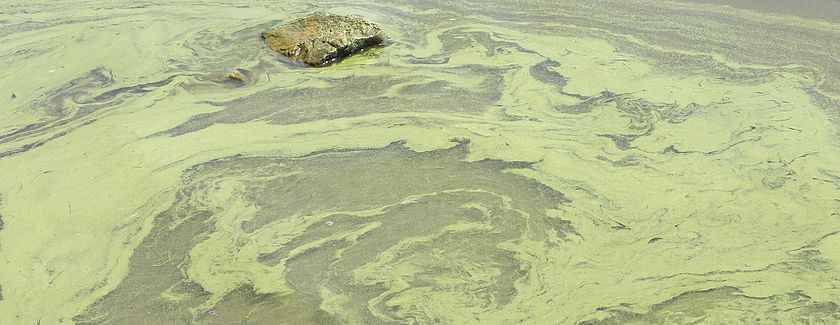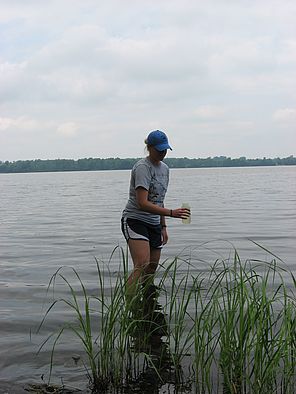
LCC Cyanobacteria Monitoring Program

LCC initiated a cyanobacteria monitoring program on Lake Champlain in 2004. We annually train and enlist community volunteers to observe and report on water conditions. Our award-winning program provides critical data on where and when blooms are happening. The information we gather is used by public health officials to assess whether the water is safe for swimming.
We are monitoring cyanobacteria, sometimes called blue-green algae, because blooms sometimes produce toxins that are harmful to people and pets. Volunteers are trained to avoid personal exposure. The point of the monitoring program is to raise awareness of the issue, build a database of information on the bloom frequency and be sure that any potential health hazards are recognized and avoided by all people. Visit the Vermont Department of Health's website for more cyanobacteria facts.
We revamped the program in 2012 to involve more people and cover more territory. Volunteer monitors commit to going out once per week from mid-June through mid-fall if possible. (Cyanobacteria blooms are occurring later in the year so we are looking for monitors who can continue assessing conditions into late October if possible.) Observations are submitted via an online form and used to update the Lake Champlain Cyanobacteria Tracking map. Repeatedly visiting the same site helps us know of not just the presence of blooms, but also their absence. LCC provides training in detecting blooms and distinguishing them from other floating phenomena. If you are interested in being a volunteer monitor or supporting this program, please contact us at (802) 658-1414 or lcc@lakechamplaincommittee.org.
Stay Informed
The Vermont Department of Health has the latest updates on Lake Champlain bloom conditions. Helpful locations on their website include the Lake Champlain Cyanobacteria Tracking map and Guidance for Vermont Communities on the health affects of cyanobacteria blooms. To help people distinguish cyanobacteria from other floating phenomena in the lake, the Lake Champlain Committee has prepared a pamphlet recognizing cyanobacteria in Lake Champlain.
Background on cyanobacteria

Cyanobacteria naturally occurs in lakes and have existed on earth for millions of years. Under the right conditions they form large accumulations referred to as blooms. Some types produce toxins which release into the water when cyanobacteria die and break down. The toxins can present a potential hazard to people and their pets. However, not all cyanobacteria produce toxins, and even those species that can produce toxins do not do so in all instances. You cannot tell by looking at a bloom whether or not toxins are present. Specialized tests are required to tell whether a particular bloom actually contains toxins.
What do cyanobacteria blooms look like?
As a bloom develops you may notice fuzzy green pinhead size balls in the water. The actual bloom often looks like thick pea soup. You may see patches of turquoise blue as cells break down and release their pigments.
What are the health concerns with cyanobacteria?
Compounds produced by the cyanobacteria can trigger skin irritations and gastro-intestinal illness. Toxins in aerosols may cause itching and irritation of eyes, nose, or throat. Some species produce toxins that affect the liver, while other species’ compounds affect the nervous system. Cyanobacteria toxins are also suspected carcinogens. Children and dogs are most vulnerable for a number of reasons: they are less particular about what they eat or drink or where they swim; they are smaller; and they are more likely to ingest water. Dogs can receive a larger dose of toxins when they swim in a bloom then lick their fur. The deaths of two dogs during the summers of 1999 and 2000 were attributed to cyanobacteria poisoning from Lake Champlain water.
Where are blooms most likely to occur on Lake Champlain?
Cyanobacteria blooms tend to be more prevalent in warm, shallow waters such as Missisquoi Bay. Deep, cold water locations with fewer nutrients, such as the Main Lake are less likely to support blooms. However, with warmer water temperatures associated with climate change and extensive nutrient loading from frequent storms and flooding, blooms are appearing in a broader area of the lake. Blooms are likely to occur during extended periods of calm sunny days. Wind and waves may cause them to accumulate along shorelines or in protected areas. Shifts in wind direction can move a bloom from one location to another. Cool rainy weather may disrupt a bloom.
What should I do if I see a bloom?
- Report it to the Lake Champlain Committee (LCC) using our online form.
- Avoid contact with the water in the area of the bloom. Blooms are often localized and you can recreate elsewhere in the lake.
- Keep children and pets out of the water.
- Do not drink untreated lake water. If you suspect a bloom near your intake, don't drink, cook or shower with the water. Boiling water doesn't destroy the toxins.
- See a doctor if someone gets ill after exposure to a cyanobacteria bloom and report conditions to the health department.
What can we do to prevent cyanobacteria blooms?
Cyanobacteria blooms result from too much nutrient loading to the lake; preventing them requires a long term strategy. Once there's a base of nutrients, temperature and weather patterns can influence where blooms appear. LCC works diligently to address root causes and advance efforts to reduce nutrient loading. We have championed bans on phosphorus in lawn fertilizer and laundry and dishwasher detergents and continue to advocate for stringent water protection regulations and enforcement, stormwater controls, upgrading and maintaining wastewater treatment plants, and investments in water protection and restoration. At a personal level there are a number of steps you can take as described in our Lake Protection Pledge. These include using only phosphorus-free fertilizers, cleaning storm drains, preventing leaves and grass clippings from entering waterways, maintaining or planting native trees and shrubs around shorelines and streams to reduce erosion, properly maintaining your septic system, and many more. You can also play an important role by actively advocating for investment in protecting and restoring our waterways.
Financial Support & Collaborative Partners

LCC's cyanobacteria monitoring program is generously funded by LCC members and the Lake Champlain Basin Program. Please contact LCC if you'd like to contribute to this program. Collaborating partners include New York and Vermont public health, environmental and recreational agencies and the Lake Champlain Basin Program.
LCC's Past and Ongoing Projects

- Raised awareness of increase in cyanobacteria blooms and pushed for research and monitoring to understand causes.
- Established and run a volunteer monitoring program for Lake Champlain and inland lakes. We train community members, recreational staff, water treatment personnel to recognize cyanobacteria and provide tools for them to report blooms. Information gathered is shared with state and municipal health and environmental agencies and made publicly available through an interactive data tracker housed on the VT Dept. of Health website.
- Produced a brochure to help distinguish cyanobacteria from other floating phenomena in Lake Champlain.
- Conducts weekly surveys of public access points around the lake during the summer. Sign up here to receive weekly emails on cyanobacteria conditions.
- Advances policies, programs and regulations to reduce nutrient loading to Lake Champlain.


